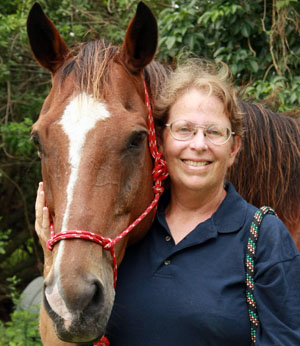TALES FROM THE TRAILS
Sometimes fate knocks you over the head and drags you off into uncharted territory. Such was the case with Bob Roffman.
Originally from Boston, he was an army reservist from 1979 until 1988 and eventually ended up living in Concord, N.H., as a medical massage therapist. But the cold winters took a toll, and he decided to move someplace warmer. He settled in Charlotte, N.C.
“I didn’t know anyone there, no family or friends,” he said. “I figured it’d be an adventure. However, there wasn’t much going on there in terms of making a living. I revisited what I was doing and attended an EAGALA conference.”
The Equine Assisted Growth and Learning Association is a nonprofit that uses horses in mental health and developmental therapy services, such as equine-assisted psychotherapy and equine-assisted learning.
“I had zero horse background,” Bob recalled. “I was investigating a possible new career path. After I watched some demonstrations, the farm owner asked what I’d like to do next. I saw some horses grazing from a round bale in a field, so we walked over.”
This led to an impromptu equine massage.
“I stood between two of the horses, resting my hands on each one, and without thinking, I started massaging one horse’s shoulder,” he said. “The owner was astonished and asked, ‘How’d you know he was lame there?’ I had no idea what she was talking about, but ended up massaging both horses wherever they seemed to want me to work, pretending I knew what I was doing. When we left the field, three horses trailed after me, apparently wanting me to do something to them. Again, the owner was amazed.”
The owner suggested equine massage as Bob’s new career. “One week later, she forwarded my name to Jim Masterson, who runs the Masterson Method of Equine Integrated Performance Body Work. I took a weekend seminar with him. He watched me work, told me I had a gift, and offered to train me,” Bob said. “I was skeptical. All I knew about horses was which end ate, which end pooped, and that they were intimidating and could be dangerous. But here were these knowledgeable people urging me on. I took it as a clear sign.”
Bob spent a year learning the Masterson Method and started building his business. In addition to being nationally certified in therapeutic massage and bodywork, and a medical massage therapist certified in the Masterson Method, he is also knowledgeable in equine cranial sacral therapy, Reiki and equine kinesiology taping.
Six years later, his business, Performance Equine Bodywork, serves clients up and down the East Coast and in the Midwest, as well as top show barns. Bob’s mentor, equine sports massage and cranial sacral therapist Bill Stanton, opened up the world of A-circuit shows. Now he follows the shows, spending much of the year on the road.
“This is the best career ever,” Bob said. “Each horse is a challenge. I learn something new from each one.”
This winter he’s in Wellington, and I was lucky enough to meet him and have him help one of my horses.
A few months ago, I became hypnotized by a mare and ended up bringing her home, even though she was the most profoundly lame horse I’d ever seen.
Vets couldn’t pinpoint the problems. Amy Cedarburg, a friend who also practices cranial sacral therapy, came out regularly to work on her, and in January brought along Bob.
“Don’t tell me anything,” he instructed me. “I have only two questions: Was she injured in the past six months? Does she have any dangerous behaviors?”
I answered no to both, and he started palpating her to find the root of her problems. As soon as he touched her poll, just behind her ears, she reacted as violently as if she’d been hit by a Taser. He continued checking her, finding restrictions in both shoulders, TMJ joint, stifles and lower back.
Then came the good part, the massage and stretching. I enjoyed watching. Bob is 6 feet, 7 inches tall, and next to him my big mare looked like a pony. By the time he had finished, the mare stood comfortably. He massaged her poll without any reaction at all.
“Got rid of her migraine,” he commented, and arranged to come back twice more.
“Would she ever be sound enough to ride? “I asked.
“I can’t say for sure,” he answered, “but she’ll feel a whole lot better.”
Bob enjoys finding areas of discomfort in a horse and resolving them. “I know what it’s like to live with chronic pain. I had a bad motorcycle wreck some years ago, so I can relate. When I relieve tissue restrictions, it provides relief and allows the energy to flow naturally again. The horse and I both feel better afterward.”
One of the key things is connecting the front end with the hind end so there’s fluidity and complete range of motion, he explained.
“Sometimes I work alone, but I also work as part of a team with vets, chiropractors and massage therapists. Whether the horse is a top competitor or someone’s backyard pet, my goal is always the same: making the horse more comfortable and, therefore, more athletic,” Bob said. “A comfortable horse will willingly try to do whatever you ask. If there are behavior issues, they may indicate physical causes. There’s usually a good reason why horses say no. When in doubt, give me a shout.”
My mare felt so much better three days later that she was completely sound working on a lunge line. I could hardly wait for Bob to come back and work on her again.
For more information about Bob Roffman, visit www.performance-equine-bodywork.com or call (704) 689-8661. For information about Amy Cedarburg, visit her Facebook page at “New You Massage Therapy” or call (561) 352-0630.








